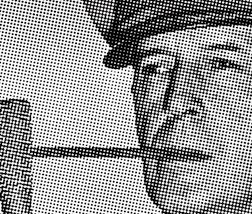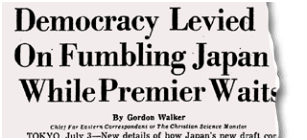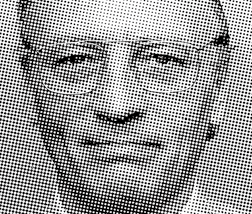Issue:
How a journalist infuriated MacArthur by breaking the story of the real authors of Japan’s Constitution.
On the 70th anniversary of the end of World War II, various issues regarding post-war history are being debated around the world. Among them is one of the most contentious subjects in Japan: the Constitution its creation, its value and its future. Prime Minister Shinzo Abe, who has long advocated a departure from traditional post war government policy, has regularly pushed for revising the Constitution. While campaigning in the general election that brought him to power for the second time in 2012, Abe went as far as remarking, “It’s a disgraceful Constitution. Speaking frankly, that’s because it was not written by Japanese.”
Of course, the document also has its defenders, who say it was the basis for the many years of peace and prosperity the county has enjoyed in the post-war era. But, irrespective of the position people take toward the Constitution, no one can doubt the impact it has had on the nation.
The process by which Japan’s Constitution was created was bizarre right from the start. For six years and eight months of U.S. Occupation following the country’s defeat in August 1945, the country was being run by the GHQ General Douglas MacArthur’s General Headquarters. During this period GHQ oversaw not only the demilitarization of Japan, but the reform of its governance: the democratization of its political, economic and social systems. The trump card in this massive process was overseeing the drastic revision of the Constitution of the Empire of Japan (also referred to as the Meiji Constitution) that dated back to 1890.


The U.S. involvement began on Feb. 3, 1946, when Courtney Whitney, GHQ’s Government Section Chief, issued a top-secret order to his assembled subordinates. He’d been ordered by General MacArthur, the “Supreme Commander,” to produce a draft of a new constitution.
Two days earlier, the Mainichi Shimbun had scooped its competitors with a story featuring the proposed constitutional revisions of the Japanese government committee led by the legal scholar Joji Matsumoto, who’d been appointed to the post by the Cabinet in October 1945. MacArthur’s GHQ was dismayed, calling it overly conservative and nothing more than a rewording of the old Meiji Constitution. Particularly infuriating were passages concerning the status of the Emperor, which remained nearly unchanged.
Whitney assigned the staff of GHQ’s Government Section to form committees to produce the various sections of the constitution: legislative, judicial, the role of the Emperor, and so on. Huddled in the Dai-Ichi Life Insurance Building and working around the clock, the staff completed a draft in just over a week. This was a top-secret project even within the GHQ.
“Inconsistent with Japanese Tradition”
On Feb. 13, Whitney handed the MacArthur-approved typewritten draft in English to Prime Minister Kijuro Shidehara’s Cabinet. It included sections that ensured civil liberties, strengthened parliamentary control and, in a move that remains controversial today, renounced war. The draft shocked the officials, with Foreign Minister Shigeru Yoshida complaining that it was inconsistent with Japanese tradition.
The government was told that if the new draft was not accepted, the Americans would take it directly to the people, sidelining the entire Japanese political structure. In the end, they had no recourse and the draft was accepted at an extraordinary cabinet meeting on March 6. None of this backroom maneuvering was reported by the Japanese press.
General MacArthur wasted no time in issuing an announce-ment, which read, “It is with a sense of deep satisfaction that I am today able to announce a decision of the Emperor and Government of Japan to submit to the Japanese people a new and enlightened constitution which has my full approval.” With nearly the entire Japanese population oblivious to the document’s real authors, the Diet’s deliberations on ratifying the constitution commenced.
In the midst of the process, on July 3, a shocking article appeared in the Christian Science Monitor. The headline of the scoop read: “Democracy Levied On Fumbling Japan While Premier Waits.” The text underneath reported that it had not been the Japanese government that was responsible for producing the new constitution, but American staff at the GHQ.
It read: “New details of how Japan’s new draft constitution was prepared by the Government Section of the Allied Headquarters and imposed upon a reluctant Japanese Government, whose own fumblings had failed to satisfy American occupation authorities, were disclosed today to this correspondent.
“As one of the most historic developments of the occupation, it sheds additional light on the manner in which the form, if not the feeling, of democracy is being brought to Japan.
“It is, moreover, a significant chronicle of how for the first time in history a democratic character has been given to a nation not because its people had any special yearning for the Western style of democracy but virtually because they had no choice in the matter.”
The article continued: “Through skillful manipulation of the Japanese press, it was made to appear that the initiative for this bold step had come from within the walls of Tokyo’s Imperial Palace.”
The author of the article was one Gordon Walker, the Christian Science Monitor’s Chief Far Eastern correspondent and a member of the Tokyo Correspondents’ Club (forerunner of the FCCJ). After joining the paper in 1933, he had worked as a war correspondent in the Pacific theater, in places like New Guinea and the Philippines.
MacArthur and his GHQ went ballistic over how the top secret project was leaked, particularly to a foreign correspondent. The GHQ went so far as to send military police to the Correspondents’ Club looking for Walker, but nothing came of the search, and calmer heads must have prevailed in cooling down the agitated response.
Gordon Walker’s “Deep Throat”
So how was Walker able to obtain the inside details of the constitution’s revision, and who was his source? His “Deep Throat” was a 30-year-old Japanese woman named Haru Matsukata, who was then working as an assistant at the Monitor’s bureau.
Born in Tokyo in 1915, Haru Matsukata was the granddaughter of Meiji-era statesman Masayoshi Matsukata. She attended the American School in Japan, and later graduated from Principia College in Illinois. Following the war’s end, she was offered a job by the Occupation, but turned that down to put her language ability to work as Walker’s assistant at the Monitor. As she was to later write in her autobiography, Samurai and Silk, “I accepted Gordon’s offer as being more likely to permit me to renew my youthful hopes of working for better understanding between Japan and America.”

“My first entry into the Press Club was in 1946 with a .45 strapped to my side, hunting down a correspondent”
Haru had obtained the inside information from her friends, including her relative Saburo Matsukata, who worked as chief editor of the Kyodo News Agency. Translating the information into English, she passed them along to Walker. One of these was an item about the writing of the Constitution. As Haru reminisced in her book: “I remember how nervous I was about passing this information on to Gordon, since I knew MacArthur and his staff would be furious with the contradiction of a fiction the Americans were to maintain stubbornly for years. Despite my fear, I decided to let the cat out of the bag because this was indeed a major falsehood that merited exposure.”
Walker wrote follow-ups about the Constitution on July 11 and 29. In them, he used the word “fiction” to describe the official story about the writing of the draft, further infuriating GHQ. At the time, GHQ’s Public Relations Office categorized correspondents as loyal or critical, depending on whether they praised or criticized Occupation policies. The former were accorded special privileges, such as opportunities for exclusive interviews with Gen. MacArthur; the latter were subjected to blatant discrimination and harassment. Walker was clearly one of the latter, and in one instance was denied reentry after leaving Japan for an assignment in China.
The G2 Military Intelligence Section, General Staff, also monitored reporters at the press club, and investigated their political beliefs and known associates. A secret G2 report dated Feb. 27, 1947 noted that Walker was “one of the most active members of the leftist clique at the Correspondents’ Club.”
Haru Matsukata was also to feel the repercussions after her name appeared on GHQ’s blacklist for having been Walker’s informant. One day, she met Jiro Shirasu, an old family friend and close aide to Shigeru Yoshida, who at the time held the post of Vice President of the Central Liaison Office. This acted as the liaison organization between the GHQ and the Japanese government.
Shirasu, who sat at the central switchboard to the secrets of the two governments, blurted out to Haru, “I am greatly shocked that you, a granddaughter of Prince Matsukata, are a communist.” Haru began to realize that her journalistic activities were affecting her whole family. She wrote: “So I severed my connections with the press, taking a position at the Swedish legation until the end of the occupation. . . .”
Despite the “fiction” of its creation, the new Constitution was eventually promulgated on Nov. 3, 1946, and went into force from May 3 of the following year. And Walker? He went on to cover the civil war in China, the Korean War and other stories in Asia during in the 1950s. He died in 1959 at age 42.
Haru Matsukata returned to journalism after the Occupation ended in 1952, and became the Tokyo office manager of the U.S. weekly, the Saturday Evening Post. She was also the first Japanese woman to be elected to the Correspondents’ Club board of directors. In June, 1955, during lunch at the Club, she met future U.S. Ambassador to Japan Edwin Reischauer, and they were married in January of the following year.
One other person who was caught up in the drama of those days in 1946 was a young GI in the military police assigned to GHQ. Jack Russell was later to work as a Tokyo correspondent for NBC, and served as FCCJ president from July 1980 to June 1981. During a panel discussion in July 2005, held in observance of the 60th anniversary of the end of the war, Russell recalled his days under MacArthur.
“My first entry into the Press Club was in 1946 with a .45 strapped to my side, hunting down a correspondent. His name was Gordon Walker, who worked for the Christian Science Monitor. MacArthur was trying to hang this guy, as he didn’t like what Walker was writing about the Occupation.” Russell, as it turned out, didn’t take Walker into custody. “Of course, as my father was a newspaper man, I was going to cover this guy up anyway,” he confided, to approving laughter from the audience.
Eiichiro Tokumoto, a former Reuters correspondent, is an author and investigative journalist.

